Time:
The Forgotten Dimension of Art
One possible reaction to the title of my paper
might perhaps be this: ‘Why describe time as a forgotten
dimension of art? After all, quite a lot has been written on the
subject. Some philosophers of art have examined ways in which the
passing of time is represented in films or the novel. Some have
distinguished what they call “temporal arts”, such as music, which they
compare with, say, painting, in which time seems to play a lesser role.
And there have been other discussions along similar lines. So why,
someone might say, do you describe time as a “forgotten
dimension” of art?’
My answer is that
my concern is of a more fundamental kind. My concern is not the
significance of time in this or that work of art, but the general
relationship between art and time: not the various functions of time
within individual works, but the temporal nature of art per se
– that is, the effect of the passing of time – of history if you like –
on those objects, whether created in our own times or in the distant
past, that we today call ‘works of art’. Described in broad terms, my
topic is the capacity of works of art to endure over time – and, above
all, the way they endure. This question has
been largely forgotten. Very little has been written
about it in recent decades, and what has been written, as I’ll argue
shortly, has skirted the crucial issues. In the time available, I want
to explain carefully what I mean, and why I think the issues at stake
should not continue to be neglected.
Let me begin with
some simple observations. It’s common knowledge – a cliché, one might
almost say – that those objects we regard as great works of art seem to
have a special capacity to survive across time. It’s common knowledge,
for instance, that of the thousands of novels published in the
eighteenth century, only a tiny fraction holds our interest today, and
that for every Tom Jones or Les Liaisons
dangereuses, there are large numbers of works by
contemporaries of Fielding and Laclos that have sunk into oblivion,
probably permanently. And if we draw comparisons with objects outside
the realm of art, the point is equally true. We do not ask, for
example, if a map of the world drawn by a cartographer of the
Elizabethan era is still a reliable navigational tool, and we know that
a ship’s captain today who relied on such a map would be acting very
foolishly. But we might quite sensibly ask if Shakespeare’s plays,
written at the same time the map was drawn, is still pertinent to life
today, and we might well want to answer yes. The map has survived as an
object of historical interest, but it is no longer
applicable to the world we live in. Shakespeare’s plays, on the other
hand, are not just historical documents. They have endured in a way the
map has not.
There are endless
examples of this point and I won’t try your patience by providing any
more. Stated in general terms, the proposition is simply this: that
those objects that we today call art – whether they be (for example)
Shakespeare’s plays, the music of Vivaldi, or great works of ancient
Egyptian or Buddhist sculpture – seem to possess a special power to
endure – a power to defy or ‘transcend’ time. This observation tells us
nothing, of course, about the nature of that power
– about how art endures. I will come to that
crucial issue shortly. For the moment, I simply want
to make the point – which many have made before me – that one of the
characteristics of art, or at least great art, seems to be a power to
endure over time. The observation is, as I say, almost a cliché; but
it’s a cliché beneath which, I will argue, lie some particularly
important questions that have not received the attention they warrant.
One more
preliminary point before I move to the heart of the matter.
In a book published
in 2005, entitled What Good are the Arts, which
attracted considerable interest at the time, the author, John Carey,
writes that
No art is
immortal and no sensible person could believe it was. Neither the human
race, nor the planet we inhabit, nor the solar system to which it
belongs will last forever. From the viewpoint of geological time, the
afterlife of an artwork is an eyeblink. [1]
Now, it may be
superfluous to say so in this company, but Carey’s comment is an
obvious red herring. The belief that a true work of art ‘lasts’ or
‘endures’ – whether or not we use the term ‘immortal’ – has nothing at
all to do with a claim that it is somehow able to resist damage or
destruction. How many hundreds, perhaps thousands, of great works of
the past, one wonders, have been destroyed by wars, natural disasters,
iconoclasm, re-use for other purposes, or simple neglect? Indeed, the
very fragility of many works of art no doubt made them more
vulnerable than other objects to the ravages of time. The issue at
stake when we speak of art’s capacity to endure has nothing to do with physical
durability. It has to do with the apparent capacity of certain works —
a Hamlet, a Magic Flute, a work
by Titian, for example — not only to impress their contemporaries but
also to exert a fascination on subsequent ages, while so many other
works have faded into oblivion. It has to do with the apparent power of
certain works to ‘transcend time’ in the sense that, unlike so much
else in human culture — from the latest fad, to beliefs about the
nature of the gods and the universe — they continue to seem alive and
important, and escape consignment to what one writer colourfully, but
very aptly, terms ‘the charnel house of dead values’.[2]
Now, I’ve been using the terms ‘lasting’ and
‘enduring’ in a loose and general way without asking what exactly they
mean in the context of art. So I’d now like to turn to this question.
That is, I’d like to look at the vital question I foreshadowed a moment
ago of how art endures – how,
exactly, it ‘transcends time’.
It’s important to
note, firstly, that despite its neglect in recent times, this question
has a lengthy and important history in European culture, and without doubt the most
influential answer has been that art is ‘eternal’, ‘timeless’, or
‘immortal’. This idea pre-dates the birth of aesthetics, of course. It
was highly influential in the Renaissance world, and we need look no
further than Shakespeare’s sonnets to see the evidence.[3] Art defies time,
Shakespeare asserts, because it is eternal – timeless. The idea is much
more than a so-called ‘poet’s conceit’. It was a widely-held belief at
the time not only about poetry but about art in general, and it
continued to be highly influential over the centuries that followed.
We today, in our
matter-of-fact world, are, of course, inclined to smile a little at
words like ‘immortal’, ‘eternal’ and ‘timeless’, but before dismissing
them too hastily we should perhaps reflect on certain points.
First, the
proposition that art is timeless at least provided a complete
answer to the question we face. We’ve acknowledged that art has a
special capacity to endure, but in principle something might endure in
a variety of ways. It might, for example, endure
for a certain period but then disappear definitively into oblivion. It
might endure for a time, disappear, and then return – in a cyclical
way. It might endure timelessly – the alternative I’ve just mentioned.
And, as we’ll see shortly, there’s at least one other possible option.
So, by itself, the notion of enduring, important
though it is, leaves us with an unanswered question, an explanatory
gap. How, we need to know, does art endure? What is
the particular nature of its relationship with
time? Now, the claim that art is timeless provided an answer to this
question. Art, it said, endures not simply because it persists in time
in some unknown, unspecified way, but because it is impervious
to time, ‘time-less’, unaffected by the passing parade
of history, its meaning and value always remaining the same. Whatever
one may think about this solution (and I’ll shortly consider some
objections) it was at least a complete solution. It
didn’t simply claim that art endures. It explained the manner
of the enduring, and the explanatory gap was closed.
Second, it’s worth
remembering that the notion that art is timeless had a major impact on
European culture, including on our own discipline of aesthetics itself.
One obvious manifestation of this is the belief, well established by
the time of the Enlightenment, that there existed a timeless standard
of beauty established once and for all by the art of Antiquity –
exemplified by works such as the Apollo Belvedere
or the Laocoön. For the influential Winckelmann,
for instance, the best way – in fact the only way – an artist could
excel was by ‘imitating the ancients’.[4] Comments such as
this – and they are legion in Enlightenment aesthetics and art
criticism – take it for granted that great art somehow conforms to an
unchanging ideal beyond the reach of time; and, as we know, Kant
himself in the Critique of Aesthetic Judgement is
happy to suggest that there is such a thing as an ‘Ideal of Beauty’.[5] Just as Classical
art had endured by virtue of its ‘immortal beauty’ so, also, it was
thought at the time, any contemporary work that acceded to the ideal
realm of beauty – such as a Raphael, a Michelangelo or a Titian – could
partake of the same immortality.
Thirdly, how
confident are we that, at least at some subliminal level, we ourselves
are not still dependent on the notion that art is timeless? Critics and
reviewers often still speak of a writer ‘immortalising’ someone or
something in ‘timeless’ prose and those are clear echoes of the ideas
I’ve been discussing. It’s also arguable, I think, that the idea often
hovers in the background in modern aesthetics, especially analytic
aesthetics, as an unacknowledged assumption. The very fact that the
relationship between art and time is so seldom mentioned seems, after
all, to imply that art and time have nothing to do with each other,
that art is somehow untouched by time – which is, in effect, to say
that it is timeless. And, not surprisingly, I notice one prominent
aesthetician of the analytic school [Peter Lamarque] arguing recently
that the value we place on a work of art is due not only to its
historical significance but, in his words, to its capacity ‘to engage
the mind, the imagination, and the senses with some more timeless
interest’.[6]
I’ve spent some of my time so far in the realm of
cultural history and while I don’t want to dwell there any longer than
necessary, there’s one further issue I cannot omit. For at least three
centuries after the Renaissance, the belief that art was timeless held
the field virtually unopposed; but, as we know, this
view encountered a serious challenge in the nineteenth
century, especially from Hegel’s aesthetics, which placed art within
the historical unfolding of the Idea, and also from Marx’s historical
materialism. For many thinkers in the post-Marxist tradition today, art
is caught up inevitably in the processes of historical change. Like all
other human activities, they would argue, art bears the marks of its
historical context and plays its part in strengthening or subverting
prevailing ideologies and social arrangements. The implications of this
thinking are clear. Viewed from this perspective, the claim that art’s
essential qualities inhabit a changeless, ‘eternal’ realm removed
from the flow of history would be an idealist illusion, false to art
and history alike.
An obvious problem,
of course, is that if one accepts the Hegelian-Marxist view, one is
left without a satisfactory explanation of art’s capacity to endure,
a stumbling block that, interestingly enough, Marx himself recognised
when he wrote in the Grundrisse:
...the
difficulty is not so much in grasping the idea that Greek art and epos
are bound up with certain forms of social development. It lies rather
in understanding why they should still constitute for us a source of
aesthetic enjoyment and in certain respects prevail as the standard and
model beyond attainment. [7]
Marx’s statement
reflects a degree of deference to Antiquity that we today would perhaps
not share, but this aside, the basic point remains: we are still left
with the problem of explaining how art endures. So while
Hegelian-Marxist thinking undoubtedly inflicted a body blow to the
notion that art is eternal, it also left an explanatory vacuum. As Marx
implies, where do we look now for an explanation of
art’s capacity to endure? Deprived of the idea that art is eternal,
what alternative solution might we offer?
The principal aim of my paper is to highlight the
importance of this question rather than offer a solution. As I’ve
indicated, I think the question of the relationship between art and
time has been neglected, and it’s that situation, above all, that I
want to call attention to. But I do think there is a
solution, and although my time is limited, and my explanation will be
very sketchy, I’d like to give at least a broad indication of where I
think the solution lies.
Once we reflect a little on the history of art, we
quickly see that our world of art today is very different from that of
the Renaissance and very different, even, from that of the late
nineteenth century. Art no longer means, as it did for several
centuries, the works of the post-Renaissance West plus selected works
of Greece and Rome – the tradition denoted by, for example, the Apollo
Belvedere, Raphael, Titian, Poussin, Watteau and Delacroix.
Art today encompasses the works of a wide range of non-Western
cultures, such as the ancient civilizations of Pre-Columbian Mexico,
Mesopotamia, and even of Palaeolithic times; and in addition, it
includes works from earlier periods of Western art, such as Byzantine,
Romanesque and Gothic, which were long regarded with indifference if
not contempt.
Exactly why the
world of art expanded so suddenly around 1900 is a fascinating question
– and again, I think, a neglected one – but it’s not a question I have
time to consider today. The important point for present purposes is
that once we factor in this radical change in the nature of the world
of art, the claims that art is timeless or that it is simply a creature
of history – the two basic claims I’ve discussed – both
start to look very implausible. Why do I say this? Selected objects
from non-Western cultures began to enter art museums (as distinct from
historical or anthropological collections) in the early years of the
twentieth century.[8] Yet as we know –
even if we tend to forget – Europe encountered many of these cultures well
before that, but had always regarded their artefacts simply
as the botched products of unskilled workmanship, or as heathen idols
or fetishes.[9] Moreover, if we
accept the abundant archaeological and anthropological evidence,
even in their original cultural settings these objects
were never regarded as ‘art’– not, at least, in any sense of the word
art that resembles its meaning in Western culture today. Their function
– their raison d’être – was religious or
ritualistic: they were (for example) ‘ancestor figures’ housing the
spirits of the dead, or sacred images of the gods.[10] The transformation
that has taken place over the centuries in cases such as these – from
sacred object initially, then to heathen idol or ‘fetish’, and now to
treasured work of art – is obviously very difficult to square with any
notion of ‘timelessness’ – that is, a condition in which the meaning
and value of the object is immune from change.
Time and change seem, on the contrary, to have played a very powerful
role, not only in terms of whether or not the objects were considered
important but also in terms of the kind of importance placed on them.
Clearly, these objects have endured in a certain way: they are not
simply creatures of history that have lost their original significance
and are now of merely ‘historical interest’ – like the Elizabethan map
I referred to. But the manner of their enduring seems far less
suggestive of timelessness than, as the French theorist André Malraux
has argued, of a capacity for resurrection and metamorphosis – that is,
a process in which time has played an integral part which involves the
revival of an object long regarded as without interest, accompanied by
a transformation in its significance.
The point is not easy to assimilate on first encounter and a further example may help clarify it.
The so-called ‘pier statues’ of biblical figures on the portals of
Chartres cathedral are now widely considered to be among the treasures
of world art, on a par with, for example, the best of Egyptian or Khmer
sculpture, or the works of Donatello or Michelangelo. Yet from Raphael
onwards all medieval art was regarded as inept and
misconceived (hence, as we know, the term ‘Gothic’ with its original,
pejorative overtones) and consigned to an oblivion of indifference. The
revival of medieval sculpture as art[11] only began in
earnest in the late nineteenth century – that is, after some three
centuries of neglect and disdain. This is not, of course, to condemn
the intervening centuries, or to suggest they somehow lacked an
‘appreciation’ of art (an unpromising argument, given that the period
in question produced many of the major figures of Western art – and
aesthetics). It does, however, suggest an alternative explanation of
the relationship between art and time. It suggests that art does not
endure timelessly – unchangingly – but through a capacity to ‘live
again’, to resuscitate, despite periods of oblivion, its rebirths being
inseparable from a metamorphosis – a transformation in significance.
The statues at Chartres were not ‘art’ for the men and women of the
thirteenth century for whom they were created. They were sacred images
– manifestations of the Christian Revelation – and to place them on
equal footing with religious images from other cultures such as ancient
Egypt or the Khmer civilization, as I have just done, would, for their
original beholders, have been unthinkable and, in all probability,
sacrilege. These works have become ‘art’ for us
(and thus comparable with images from other religious cultures) but
they have done so through a metamorphosis – a process very different
from a capacity to remain impervious to change
implied by the notion of timelessness.
These few remarks
certainly don’t do justice to Malraux’s concept of metamorphosis. But
my time is running short and in any case the central aim of my paper
is, as I’ve said, less to advocate a particular solution to the
question of the relationship between art and time than to highlight the
importance of that question. I happen to find Malraux’s position very
persuasive because it’s coherent and explains the facts as we know
them, but I will leave his ideas now so I can comment briefly on what
has been said by recent writers in aesthetics about the question of art
and time.
As I’ve indicated,
very little has been said. And even when discussion
has moved in this direction it has not, in my view, addressed the key
issues. Let me give just two examples.
Pursuing a
well-known theme going back at least to Hume, some philosophers of art
have focused on the so-called ‘test of time’. One writer, for example,
[Anthony Savile] notes that the longevity of a work of art – its power
to ‘survive over time’, in his phrase – is often seen as an indication
of its value, and he then asks whether this view is justifiable,
eventually returning an affirmative answer.
[12]
But, as we can now see, this thinking does not go
far enough. The issue is much less to know that art
– at least great art – has a power to endure; that much, surely, is
reasonably obvious. The crucial question is how art
endures – the nature of its capacity to ‘survive’.
I have listed four possible answers: Art might survive for a certain
period and then disappear definitively into oblivion. It might endure
for a time, disappear, and then return with its original meaning – in a
cyclical way. It might endure ‘eternally’ – outside time – which, as I
mentioned, is the explanation that has figured most prominently
throughout European history. Or it might, as Malraux argues, survive
through a process of metamorphosis. So, conceivably, art might
‘survive’ in a number of ways, and to focus simply on the question ‘Does
art survive?’ is to stop short of this crucial issue.
Another debate
sometimes thought to have a bearing on the relationship between art and
time is the question of whether a work of art is legitimately
susceptible to just one interpretation, or more than one. The thinking
here, I take it, is that if the answer is ‘more than one’, then a work
of art is changed by the passing of time; and if the answer is ‘only
one’ then it is not changed.[13] But this line of
inquiry is of no help to us at all. For whatever
the number of so-called ‘legitimate interpretations’, that number could
conceivably be fixed – the fixed number of meanings
that the artist, consciously or unconsciously, gave the work at its
moment of creation. And if this is so, the work is fundamentally immune
from change irrespective of the number of interpretations – just as a
diamond is, for example, despite having multiple facets. Moreover, even
if we ignored this difficulty, we are left simply with the conceptual
framework: change/no change, which is equivalent to: change or
timelessness; and for all the reasons I’ve given these alternatives do
not give us a satisfactory purchase on the problem of the relationship
between art and time. In short, as I say, this line of inquiry is not
fruitful. Whether a work of art is susceptible to one, or a more than
one, interpretation is, by itself, of no assistance at all in
understanding art’s temporal nature: it tells us nothing about the
way art endures.
A few concluding remarks:
Perhaps someone
might say to me: ‘Yes, yes, but even if we agree, how important is
this, after all? Does it really matter? Does aesthetics need to bother
about the relationship between art and time?'
My answer has two
aspects, one theoretical in nature, one more practical.
The theoretical
aspect is this. We know that art – or at least great art – endures in
some way. We
know that for every painter, composer, or writer of the past whose
works are still admired today, thousands have faded into oblivion. And
going outside the realm of art, we know there’s a major difference
between an object such as a map preserved purely for historical
interest, and a work of art, such as a play by Shakespeare, or the
music of Mozart, which still seems vital and alive today.
So we know the simple fact that art
endures. But if we, as philosophers of art, are asked how it endures,
what do we answer? Do we say it is timeless – eternal? Few would argue
this today, I suspect, and for good reason, as I’ve tried to show. So
what do we reply?
That art is a creature of history? But that would tell us why art is affected by time,
not why it transcends it. Do we
then try to argue that art is somehow both timeless and embedded in
historical change? But that clearly won’t do. The notion of
timelessness means what it says – outside time, immune from change. To
be simultaneously changing and changeless is not a condition one can
readily imagine.
So that’s the theoretical aspect of my answer: We know that
art endures. Are we content, as philosophers of art, to leave the
question of how it endures neglected and
unanswered?
The practical issue
is this: Our modern world of art is
obviously much more than the world of modern art. The exhibitions that
greet the hundreds of thousands of visitors to today’s art museums
encompass a vast stretch of the human past from prehistoric times
onwards. And just like modern works, many works from the distant past
seem vital and alive to us despite the long periods of time since their
creation, despite the fact that so many of them did not begin their
lives as ‘works of art’, and despite the long periods during which they
were regarded with indifference or even derision. Seen in this light,
the capacity of works of art to transcend time, and the nature
of that transcendence, become very real and
pressing questions – questions posed on a daily basis to countless
visitors to today’s art museums, even if they are only vaguely aware of
them. So in simple, practical terms, we, as philosophers of art, surely
cannot afford to ignore the question of how art
endures – unless we are content to place severe limits on our
discipline’s capacity to speak to the art-loving public in useful and
relevant ways.
André Malraux once
wrote that, ‘as well as being an object, a work of art is an encounter
with time’, and this, in a nutshell, is the point I’ve been making in
this paper. Aesthetics today, as I see it, has had a lot to say about
art as an object. We’ve asked, for example, about the difference
between a work of art and a ‘mere real thing’, we’ve asked whether
works of art function as a means of ‘representation’ or not, whether
art provides a kind of knowledge and if so what kind, and a range of
other questions concerning the work of art’s condition as an object.
But we have not asked about art’s temporal nature –
the nature of its capacity to endure over time. This was once a major
theme in Western thinking about art, and I’ve briefly canvassed some
aspects of that fascinating history. Today, as I've tried to suggest, the issue is, if anything, even more important. Unfortunately, however, the discipline of aesthetics seems to have forgotten it, and our understanding of art, I would argue, is seriously impoverished as a result.
[1] John Carey, What Good are the
Arts? (London: Faber and Faber Ltd, 2005), 148.
[2] André Malraux, Les Voix du silence,
Ecrits sur l'art (I), ed. Jean-Yves Tadié, 2 vols. (Paris:
Gallimard, 2004), 890.
[3] This comment was accompanied by a slide
showing the well-known lines of
Sonnet 18:
But
thy eternal summer shall not fade,
Nor lose possession of that fair thou ow'st,
Nor shall death brag thou wander'st in his shade,
When in eternal lines to time thou grow'st...
[4] Johann Winckelmann, Reflections
on the Painting and Sculpture of the Greeks, trans. Henry
Fusseli (Menston, Yorkshire: Scolar Press, 1972), 1, 2.
[5] Critique of Aesthetic Judgement,
Book One, §17. Some writers have argued that Kant’s comments here are
inconsistent with other aspects of the Critique. That may be so; they
are nonetheless part of the work.
[6] Peter Lamarque, "The Uselessness of
Art," The Journal of Aesthetics and Art Criticism
68, no. 3 (2010): 213. Lamarque relies quite heavily on the notion of
timelessness in the concluding stages of his article, although the
issue is somewhat blurred by his formulation ‘more timeless’. In strict
philosophical terms (which is what matters here), the word 'timeless'
cannot be qualified.
[7] David McLellan, ed. Marx’s
'Grundrisse' (London: Macmillan Ltd,1980), 45.
[8] A fact that is often forgotten. African
art, for example, had to wait until the mid-twentieth century before
being admitted into the general collections of art museums. I have
discussed this issue in some detail in Art and the Human
Adventure; André Malraux’s Theory of Art. It should be
stressed that the present analysis concerns the acceptance of the
objects in question as art. Artefacts from non-Western cultures had
previously been included in cabinets de curiosités and history museums
but that is a different matter.
[9] Cf. the comment by H. Gene Blocker:
“Although primitive artifacts were known to Europeans from the time of
the great explorations of the New World and the Far East from the 15th
century onwards, and although a few pieces were admired by artists such
as Dürer and Cellini, there was virtually no aesthetic interest in such
artifacts as works of art until the early years of the 20th century.
Gold objects from Pre-Colombian Mexico and Central and South America
were melted down and the valuable raw material shipped back to Spain; a
few pieces were taken back to the home countries as evidence of the
culturally savage and barbaric state of the natives; and what aesthetic
response there was was largely one of horror at the ugliness and
brutality supposedly symptomatic of these savage, heathen works of the
devil.” H. Gene Blocker, The Aesthetics of Primitive Art
(Lanham: University Press of America, 1994), 272.
[10] I am aware that some philosophers of
art do not accept these views, arguing that no matter what the peoples
of non-Western cultures may have said or done, they “really” or
“fundamentally” regarded such artefacts as art in some sense similar to
our modern meaning of the word. There is no space to do justice to this
question here, important though it is. I have discussed it at some length in my books Art and
the Human Adventure; André Malraux’s Theory of Art and Art and Time. However,
even if one were to reject the claim that the cultures in question did
not regard their artefacts as art, the previous point remains intact –
that is, that, for centuries, European cultures regarded them as merely
the botched products of unskilled workmanship, or as heathen idols or
fetishes, never as art. In many cases they were melted down or
otherwise destroyed to recover the precious metals and jewels.
[11]
As distinct from a component
of medieval history or a picturesque element in historical novels,
developments that occurred somewhat earlier.
[12]
See Anthony Savile, The
Test of Time: An Essay in Philosophical Aesthetics (Oxford:
Clarendon Press, 1982). Cf: also the comment: ‘…only with the passage of time can we
become certain of the security of [artistic] value. Hence the test of
time is necessary for stable evaluations of historical importance or
worth.’ Alan H. Goldman, "Art Historical Value," British
Journal of Aesthetics 33, no. 3 (1993). See also: Anita
Silvers, "The Story of Art Is the Test of Time," Journal of
Aesthetics and Art Criticism 49, no. 3 (1991).
[13] This argument surfaces in various ways,
for example, in: Jerrold Levinson, "Artworks and the Future," in Music,
Art, and Metaphysics: Essays in Philosophical Aesthetics
(Ithaca: Cornell University Press, 1990), 179–214, 180, 81. Goldman,
"Art Historical Value," passim. A similar preoccupation emerges in some
of Arthur Danto’s work. Cf: “One can discover only what is already
there but has remained up until then unknown or misrecognized.” Arthur
Danto, "Artifact and Art," in Art/Artifact: African Art in
Anthropology Collections, ed. Susan Vogel (New York: The
Centre for African Art, 1988), 18–32, 19. In
all these cases, the focus is on the mere fact of change which, as
argued here, is of no help in addressing the issue at stake. (I am
leaving out of account here attempts to add an historical dimension to
‘institutional’ notions of art such as Jerrold Levinson’s idea of a
chain of ‘art regards’. This is only tangentially relevant to the
present discussion and is in any case open to serious objections. I have
outlined these in Art and the Human Adventure; André
Malraux’s Theory of Art and in Art and Time.)
This is a paper I delivered at a meeting of the Dutch Association of Aesthetics in Ghent, Belgium on 27 and 28 May 2011. It outlines key questions to be addressed in considering the temporal nature of art - a major issue which, as I say in the paper, has been widely neglected in modern aesthetics.
I accompanied the paper with a Powerpoint show which included images of relevant paintings and sculptures. A number of these are shown below.

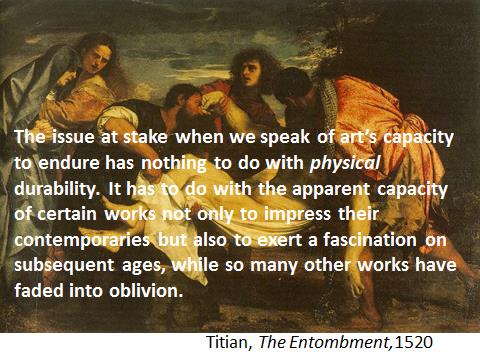
Nor lose possession of that fair thou ow'st,
Nor shall death brag thou wander'st in his shade,
When in eternal lines to time thou grow'st...
Shakespeare, Sonnet 18
The notion that art is timeless had a major impact on European culture, including on our own discipline of aesthetics itself.
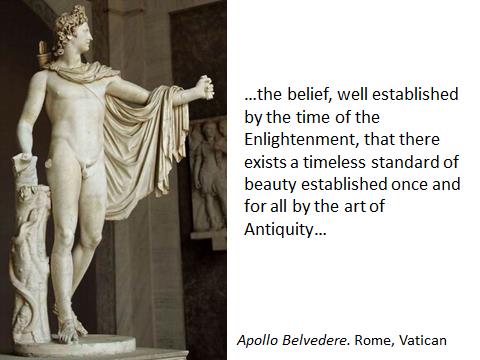
It’s arguable that the idea that art is timeless often hovers in the background in modern aesthetics, especially analytic aesthetics, as an unacknowledged assumption.
For many thinkers in the post-Marxist tradition today, art is caught up inevitably in the processes of historical change.
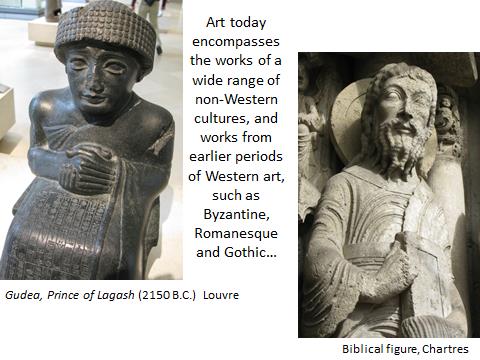
Once we factor in this radical change in the nature of the [modern] world of art, the claims that art is timeless or that it is simply a creature of history both start to look very implausible.
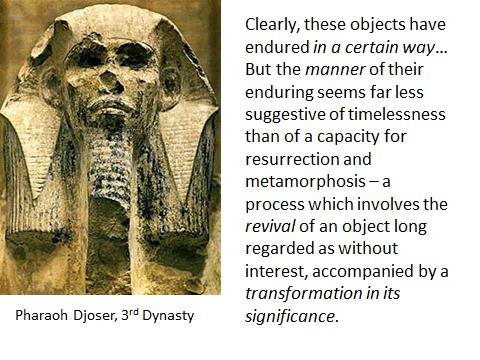

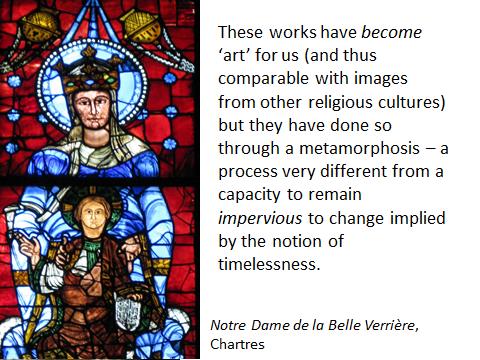
Whether a work of art is susceptible to one, or a more than one, interpretation is, by itself, of no assistance in understanding art’s temporal nature: it tells us nothing about the way art endures.
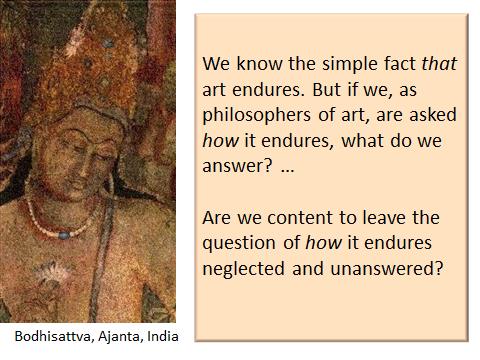

André Malraux once wrote that, 'as well as being an object, a work of art is an encounter with time'.